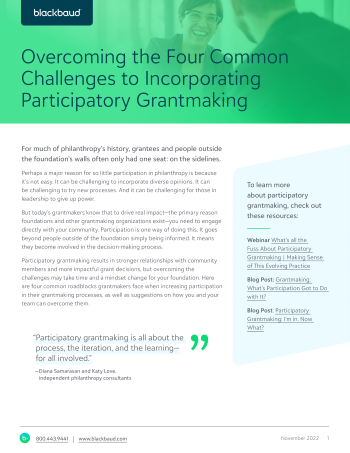The Different Types of Grant Reviews: What Grantmakers Need to Know

After a lot of research, conversations with community members, and writing—and re-writing—questions, your application for funding is live. And you are getting submissions. Great submissions.
Now comes the most rewarding—and hardest—part of your grant cycle. Reviewing the applications and selecting the organizations to fund.
Choosing how your organization reviews grants—eligibility, internal, external, or peer reviews—is not a one-size-fits-all decision. The type of grant reviews your funding organization uses will depend on the number of applications you receive, your technology, and the goals of your grant program.
Here is a breakdown of the different types of grant reviews, who is involved, what programs they work best for, and what to keep in mind with each type.
Eligibility Reviews: A Timesaving First Step
The first review in most processes is a check for eligibility. Your grants management system can help you limit the number of incomplete or unqualified applications, but you still need someone to do a quick review to make sure the information provided is what you need to make an informed decision.
The process typically begins with an eligibility quiz within your application portal, which allows potential applicants to self-assess whether they fulfill the fundamental qualifications for the grant. By integrating these quizzes into your application portal, you can filter out unqualified applicants early and reduce the workload for your team. Application portals can also flag incomplete submissions, prompting applicants to address any gaps before submitting. This minimizes delays caused by missing information.
Once an application is submitted, a grants manager or administrative staff member conducts a quick review to confirm the submission is complete and accurate. This includes validating IRS status, checking for required attachments, and ensuring the information provided aligns with your program’s goals. Additionally, this step offers an opportunity to verify and update applicant records in your CRM, avoiding duplicate entries and ensuring data integrity.
The eligibility review is an important part of your review process to make sure everyone’s time is respected—your applicants, your staff, and your reviewers. With the help of a good grant management system (GMS), this process should take less than an hour per application.
Internal Reviews: Building on a Culture of Collaboration
Internal reviews involve staff, leadership, and trusted volunteers within your organization to evaluate grant applications. This type of review process works best for organizations with small application pools, mostly returning grantees, or as a first step to a longer external review process.
With internal reviews, you are able to use the team’s intimate understanding of organizational priorities and past funding efforts. For organizations with a culture of strong collaboration, the internal review process can be incredibly efficient. It may also be more practical for smaller organizations without access to a GMS to facilitate external reviews.
Even so, you need to keep in mind that the balance of power within the group can influence outcomes, especially if leadership members participate. A recommendation from a higher-ranking team member might inadvertently sway others’ decisions. To mitigate this, it’s crucial to foster open communication and make sure your evaluation criteria is documented thoroughly.
External Reviews: Bringing in Diverse Experiences
External reviews bring valuable perspectives to your grantmaking process by incorporating voices beyond your organization. These reviews are especially beneficial for programs requiring diverse insights or handling a high volume of applications that exceed your internal team’s capacity.
Participants often include community stakeholders, previous grantees who are no longer eligible, individuals from partner organizations, or members of the population your grant will support—such as students for youth-focused initiatives. This diversity allows your organization to tap into expertise and lived experiences to make better funding decisions.
External review processes work well for funders with strong community-focused programs. This process enables you to incorporate more diverse opinions and experiences than you might have on staff. For example, if you are working on helping people who are experiencing homelessness but no one on your staff has ever been in that situation, it helps to bring in social workers and others with more lived experience to review those applications.
This type of grant review is also beneficial for grantmakers with a significant number of applications. More people help you make decisions faster and get funding to grantees sooner.
Because external reviews often involve people who have less experience with your organization, it’s important to have clear, well-documented evaluation criteria and training. Most organizations that use external reviewers provide a stipend for their reviewers’ time, and depending on the audience, needs like childcare. It’s also important to share your conflict-of-interest policy and make sure everyone involved has an opportunity to disclose any potential conflicts.
External reviews are a key part of Participatory Grantmaking. Learn more about this collaborative process and whether it might be a good option for your organization.
Peer Reviews: Getting a Specific Perspective
While similar in many ways to external reviews, a peer-review process for grant applications includes only those who are in a similar position to the applicant. While the reviewers have a significant understanding of the issues, you as the funder need to have additional guardrails in place to ensure consistency and privacy.
This approach is particularly effective for programs requiring deep technical knowledge or community-driven perspectives. For instance, research-focused grants often benefit from reviewers who understand the complexities of proposed studies, while community programs can engage past grantees to offer informed feedback.
Participants in peer reviews typically include current or former grantees because their direct experience allows them to assess applications through a practical lens. They understand the challenges and opportunities of implementing projects like those proposed in the applications, which strengthens decision-making.
However, peer reviews require thoughtful planning to avoid conflicts of interest and ensure fairness. Establish clear guidelines and guardrails so participants disclose any personal or professional connections to applicants and adhere to strict confidentiality policies. These measures prevent bias and protect sensitive information, ensuring the process remains equitable and trustworthy.
Peer reviews can foster collaboration and a sense of community among stakeholders. With careful implementation, peer reviews can amplify expertise and support fair and impactful funding decisions.
Tips for Reviews No Matter the Format
Regardless of how you manage your reviews, there are a few best practices that will keep your processes moving smoothly so you get funds to your grantees quickly. Here are a few tips for a seamless review process, no matter which format you use to review applications.
Mission-Aligned Application
Start with a strong grant application that makes it easy to tie the answers back to your mission and rubric. When there is a clear relationship between a question—how does this program support youth literacy—and your mission—to improve the literacy rates and love of reading for K–12 students in Johnson County—it’s easier for your reviewers to assess whether it aligns with your funding goals.
Clear and Documented Success Criteria
You need a detailed rubric, so your reviewers know what they are looking for in the application. Provide training for your success criteria, either live or recorded, and include examples of what “good” looks like. If you are asking about the community need for the project, let the reviewers know they should expect to see demographic statistics or comments from community members. Hint: your applicants should know those expectations as well.
Diverse Experiences Within Your Reviewer Pool
Recruiting a variety of people to review applications may be easier for some review types than others, but make sure even your internal reviewers have a broad range of perspectives. You want to make sure you aren’t missing quality applicants because of a misunderstanding or unintentional bias. For internal reviews, rotate in staff members who wouldn’t otherwise participate, such as your staff accountant or marketing intern. They’ll feel more engaged in your mission, and you can get a fresh perspective in your reviewer pool.
Documented Conflict of Interest Policy
Among the most important policies for your organization is the conflict-of-interest policy. You want to make sure all decisions made are for the right reasons—getting needed funds to organizations that will drive the most impact for your mission. Create a process for making sure reviewers read, agree to, and report any potential conflicts prior to reviewing grant applications.
Strong Reviewer Portal for Consistent and Automated Workflows
The review process can get complicated quickly when people are shuffling paper or juggling versions of spreadsheets. With a grants management system that manages both your application and your review process, you can build consistent, automated workflows that streamline the process for everyone.
Primary Contact for Each Program
Provide a contact person for the reviewers to go to with questions or issues. It might be one person to handle all review processes, or you may have a specific person for each grant program. This helps the review process move smoothly because questions are less likely to be lost in the shuffle and answers are more likely to be consistent.
Strong Grant Review Workflows Start with an Intuitive Grants Management System
The review process is the culmination of an incredible amount of work by both your staff and your applicants. You want to be able to make informed decisions quickly so you can get funds to your grantees, and they can build their programs or continue their important work.
A grants management system built for grantmakers can help you build streamlined workflows for your review processes. As a single source of truth for all your grantmaking, your GMS makes it easy to build, collect, and review applications while keeping your information secure and easy to find.
Ready for a GMS that streamlines your grantmaking workflows? Learn more about Blackbaud Grantmaking™ with our on-demand product tour.
 Free Resource
Free Resource
Tips for Bringing Your Community into Your Decision-Making Process
Overcoming the Four Common Challenges of Participatory Grantmaking




